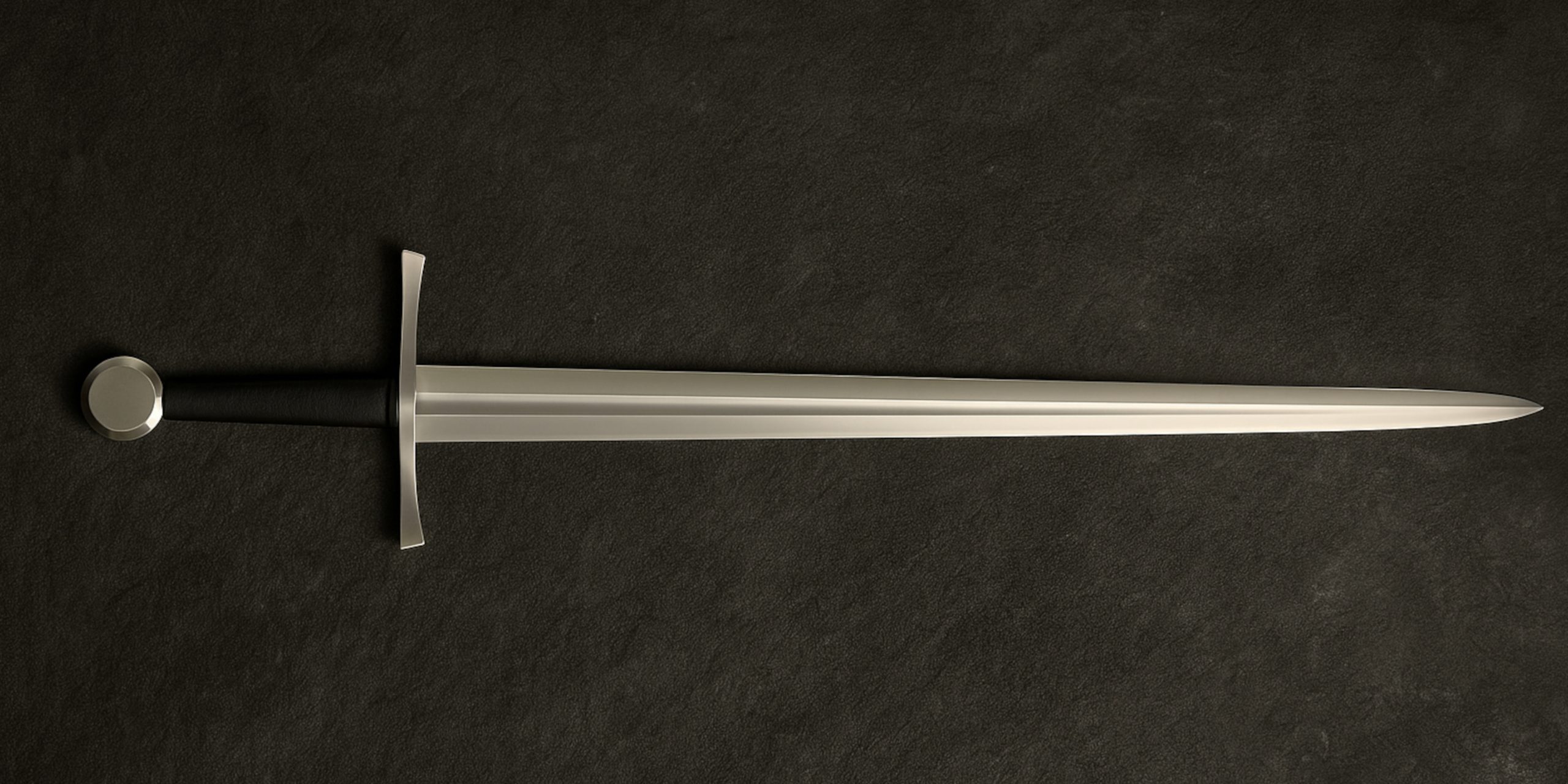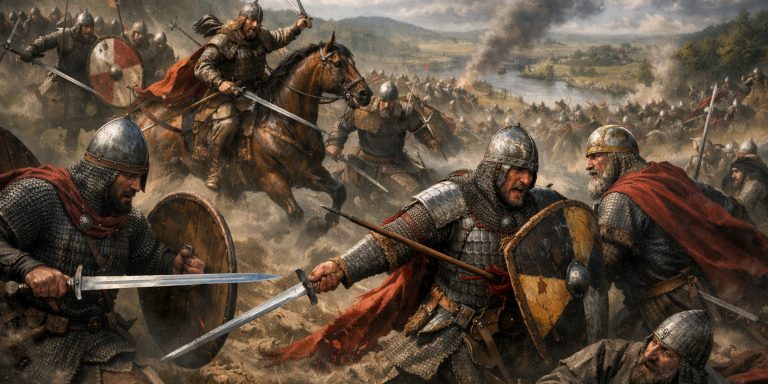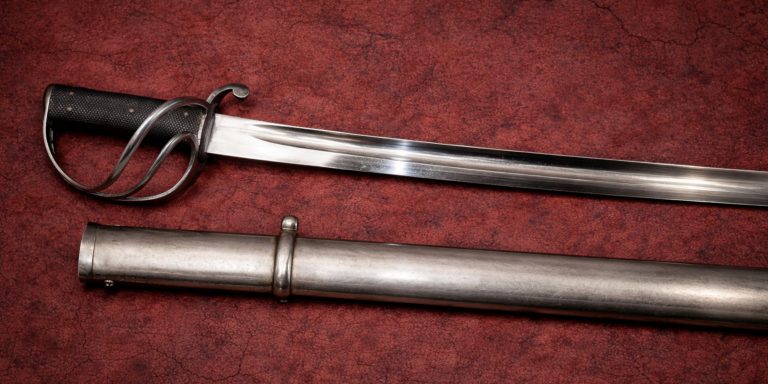
The Oakeshott Type XII is one of the most recognisable and widely used sword forms of the High Middle Ages, roughly spanning the 12th to early 14th centuries. It represents the archetype of a knightly sword: broad, double-edged, with a long fuller and a blade optimised for cutting without sacrificing the ability to thrust.
This type marked a transition from the heavier, broader cutting swords of the Viking age toward the balanced knightly arming swords of the Crusader period. Its design reflects both the martial and cultural ideals of its time, when mail armour still dominated and swordsmanship emphasised powerful, controlled strikes.
Specification
| Feature | Description |
|---|---|
| Blade Type | Broad, evenly tapering double-edged blade |
| Fuller | Long and pronounced, typically extending two-thirds to three-quarters of the blade |
| Length | 75–90 cm (30–36 in) |
| Grip Length | 9–12 cm (3.5–5 in) |
| Weight | Around 1.1–1.4 kg |
| Point of Balance | Typically 10–13 cm from the guard |
| Cross-guard | Straight or slightly curved; simple, functional |
| Pommel | Often of disc, Brazil-nut, or wheel type |
| Primary Function | Cut-focused with adequate thrusting capability |
| Period | c.1150–1320 CE |
| Region | Western and Central Europe, used by knights and men-at-arms |
History and Evolution
Ewart Oakeshott classified Type XII as the defining sword of the 12th and 13th centuries. Its emergence coincides with the development of mail hauberks and the growing use of surcoats and heraldry, symbols of the fully formed knightly class.
- Early Origins: Derived from late Viking and transitional Type X and XI blades. The taper became more pronounced, giving a finer point without losing cutting power.
- 12th Century Use: Dominant among knights during the Crusades, depicted in artwork such as the Maciejowski Bible (Morgan Bible).
- 13th–14th Century Decline: Gradually superseded by the more acute-tipped Type XIIIa and Type XIV as plate armour began to appear, demanding swords better suited for thrusting.
- Cultural Context: Associated with the rise of chivalric ideals and the codification of knightly combat. Many surviving examples were richly decorated, indicating status as well as function.
Advantages and Disadvantages
Advantages
- Excellent Cutter: Broad edge and balance make it powerful in downward or sweeping cuts.
- Versatile in Combat: Retains enough taper to allow controlled thrusts.
- Balanced Handling: Light for its size, responsive in one-handed use.
- Proven Durability: Forged from high-carbon steel, built to endure heavy use.
Disadvantages
- Limited Against Plate Armour: Its cutting focus makes it less effective once plate protection became common.
- Reduced Penetration Power: Compared to later thrust-oriented types (e.g. Type XV), its tip was less reinforced.
- Grip Length: Shorter hilt limits leverage, making two-handed techniques impractical.
Comparison with Similar Weapons
| Sword Type | Period | Key Features | Primary Function | Comparison to Type XII |
|---|---|---|---|---|
| Type X | 10th–12th c. | Broad, parallel edges, short fuller | Strong cutter | Type XII is lighter and more agile |
| Type XI | Early 12th c. | Longer and narrower, very long fuller | Cutting and light thrusting | Type XII has more defined taper and strength |
| Type XIIIa (Great Sword) | Late 13th–14th c. | Longer grip for two hands, wide blade | Powerful cutting and thrusting | Type XII is one-handed and more balanced |
| Type XIV | Late 13th c. | Shorter, broader blade with acute tip | Thrust-focused | Type XII is less armoured-piercing but more fluid |
| Type XV | 14th–15th c. | Diamond cross-section, rigid blade | Optimised for thrusts into plate | Type XII is earlier and primarily a cutter |
Legacy
The Type XII remains the quintessential Crusader sword, appearing in countless historical depictions and modern reproductions. It bridges the aesthetic of the Viking warrior and the knight of Christendom, symbolising both function and faith.
Its influence persists in modern swordsmithing, often serving as the base model for “medieval arming sword” reproductions. Many film and museum designs draw directly from Oakeshott’s classification, which has become the standard system for historical European swords.
Where to See
| Museum | Location | Example |
|---|---|---|
| British Museum | London, UK | 13th-century knightly sword with wheel pommel (Inventory No. 1850,0713.1) |
| Wallace Collection | London, UK | Several Type XII variants with distinctive fuller lengths |
| Kunsthistorisches Museum | Vienna, Austria | Crusader-period arming swords from the 12th century |
| Musée de l’Armée | Paris, France | Type XII sword associated with the Capetian era |
| Metropolitan Museum of Art | New York, USA | Type XII with partial gilt hilt, c.1250 CE |
Collector’s Guide and Auction Prices
Type XII swords are highly sought after by collectors for their balance of beauty, functionality, and historical significance. Genuine period pieces are rare, and condition, provenance, and regional origin heavily affect value.
Market Overview
- Authentic Medieval Examples:
- Auctioned between £25,000–£100,000 depending on preservation and documentation.
- Museum-Grade Replicas:
- From £1,000–£3,000 for historically accurate reproductions.
- Functional Modern Swords:
- Around £400–£800 for high-carbon steel versions from reputable makers (Albion, Windlass, Deepeeka).
Collector Tips
- Look for clear fuller geometry and appropriate taper to confirm Type XII authenticity.
- Verify balance and point of percussion when assessing replicas.
- Avoid swords with modern machine polishing or incorrect pommel types.
- Provenance and museum verification dramatically increase value.
Seven Swords Takeaway
The Oakeshott Type XII embodies the perfect harmony between cut and thrust, strength and elegance, function and symbolism. It was the sword of the Crusader and the knight-errant, the blade that defined an age of faith and steel. For historians and collectors alike, it represents not just a weapon but a statement of cultural identity, craftsmanship, and the evolution of European martial design.



